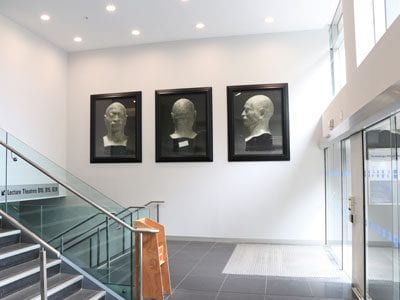
Fiona Pardington, Portrait of a life cast of Matoua Tawai, Aotearoa New Zealand, 2010.
University of Auckland Art Collection.
Te Herenga Mātauranga Whānui is now home to Fiona Pardington’s Portrait of a life cast of Matoua Tawai, Aotearoa New Zealand. Another edition of this triptych was shown in the 2018-19 Oceania exhibition at the Royal Academy of Arts, London and the Musée du Quai Branly, Paris.
The work is from Pardington’s series of photographs of life casts mostly made in 1837-40 by French phrenologist Pierre Marie Dumoutier during his travels to Oceania on the Astrolabe, under the command of J.S.C. Dumont d’Urville.1
Now housed in museums in France and Aotearoa New Zealand, the casts reveal in fine detail the cranial and facial features of Dumoutier’s sitters. Such casts were used as tools to interpret intellectual traits and character under the now discredited 19th-century pseudo-science of phrenology. Dumoutier made only a few casts of Māori; many, particularly rangatira (chiefs), refused to endure the process because of the tapu nature of the head.2
After photographing casts held in Aotearoa, Pardington travelled to Paris to photograph those at the Musée de l’Homme, resulting in the photographic series, Āhua : A beautiful hesitation, 2010. A major work from that, Matoua Tawai depicts the cast of a Māori man with a striking and intricate tā moko, or tattoo. Even though Dumoutier made notes about some sittings and research has been undertaken, mystery remains surrounding his identity.3
The triptych is part of a critical artistic process in which Pardington, of Ngāi Tahu, Kati Mamoe, Ngāti Kahungunu and Scottish descent, has reanimated dense historical and anthropological material and brought it back into the limelight. The work creates a powerful “… breathing presence, with a sense of the pulse and blood of life and the vital energy of the person whose spirit and likeness they portray.”4 It is proudly held in the University of Auckland’s Art Collection, now a part of Cultural Collections in Te Tumu Herenga.
Sam Melser, Art Collection
References
1 Baker, K. & Rankin, E. (eds.). (2011). Fiona Pardington : The pressure of sunlight falling, pp.133-136. Dunedin, N.Z. : Otago University Press.
2 Salmond, A. (2011). Et la tête : casting heads in the Pacific. In K. Baker & E. Rankin (eds.), Fiona Pardington : The pressure of sunlight falling, pp.133-136.
3 Ibid.
4 Baker, K. (2011). The truth of lineage: Time and tā moko. In K. Baker & E. Rankin (eds.), Fiona Pardington : The pressure of sunlight falling, pp.26-34.
